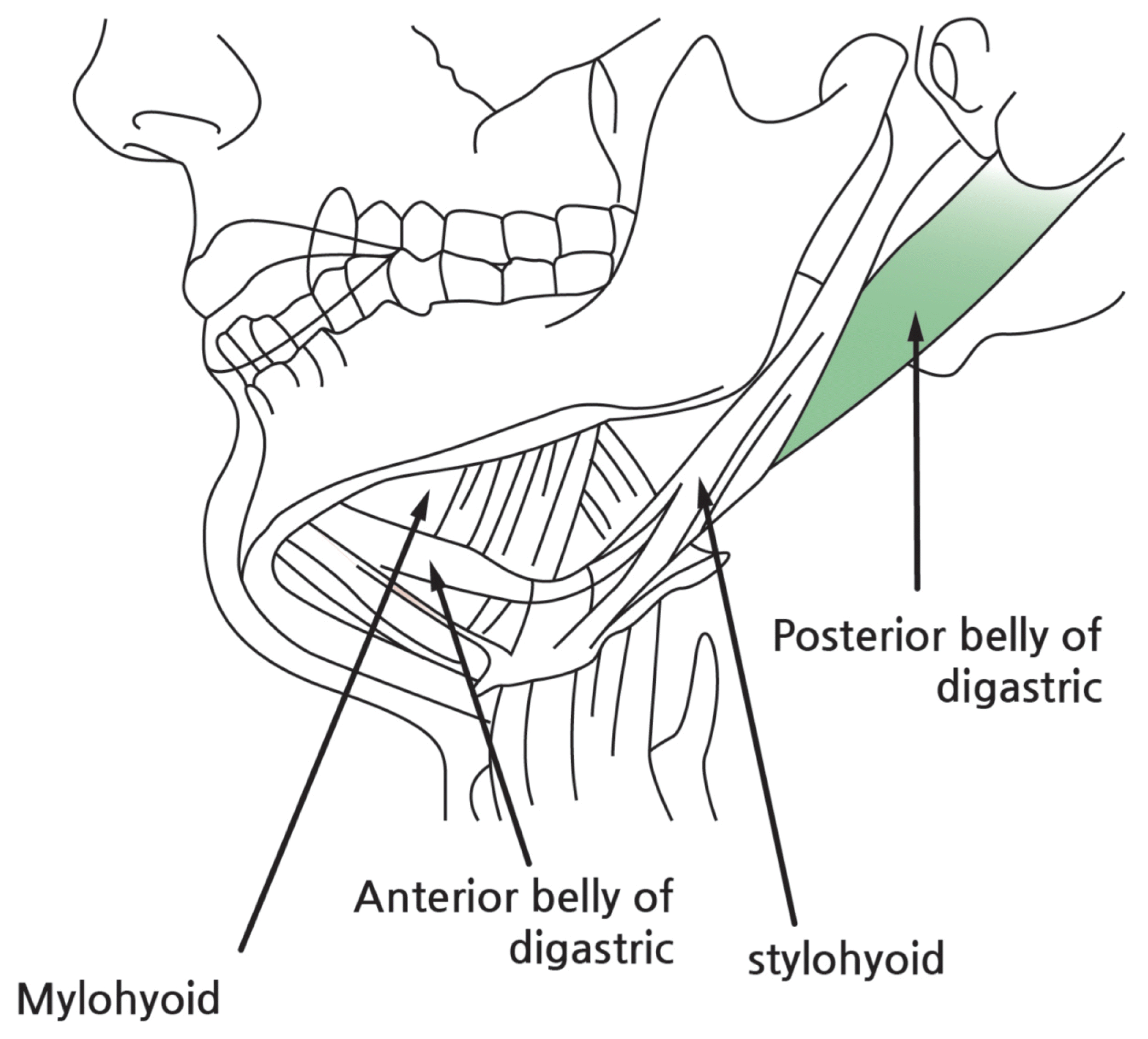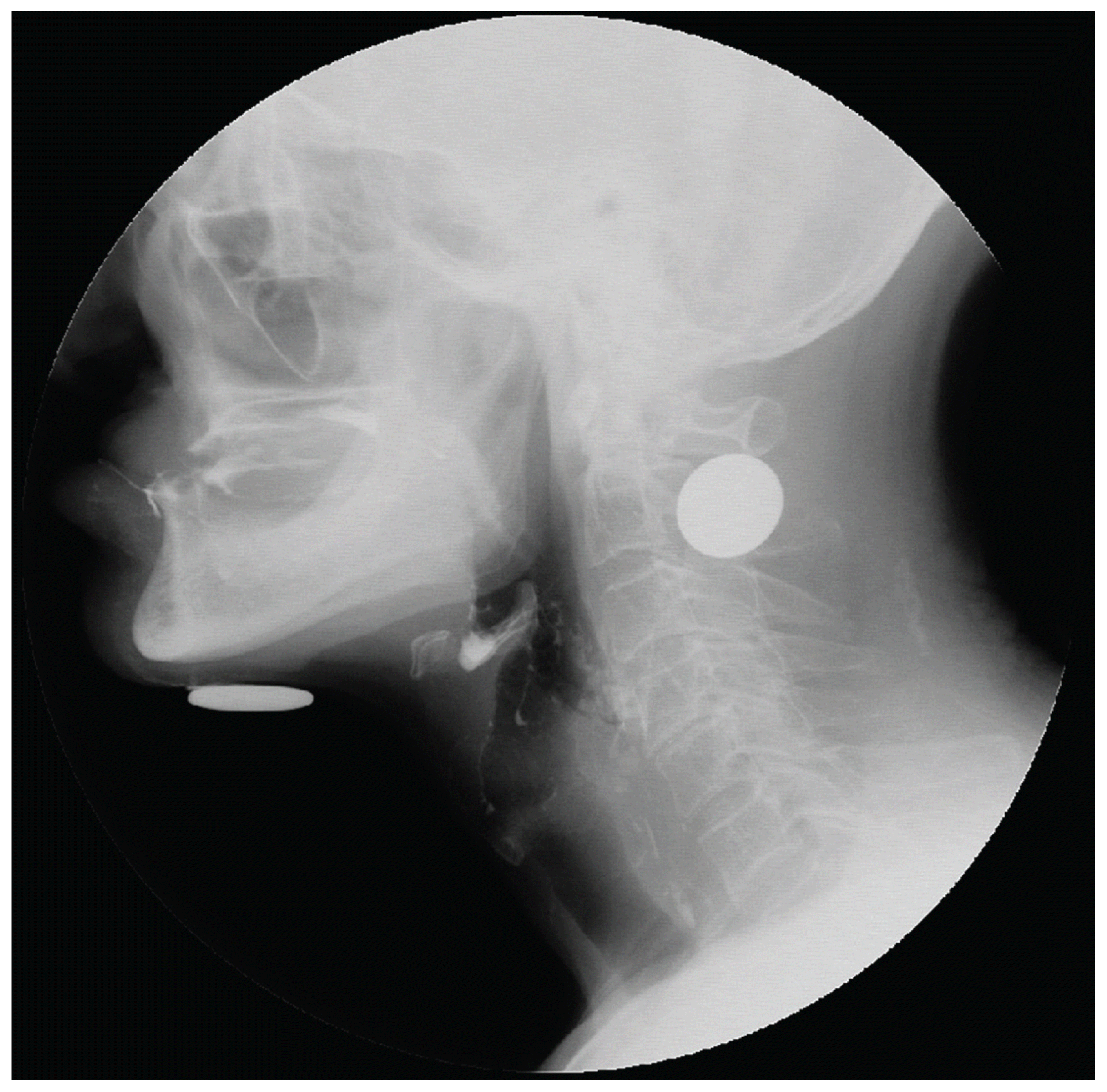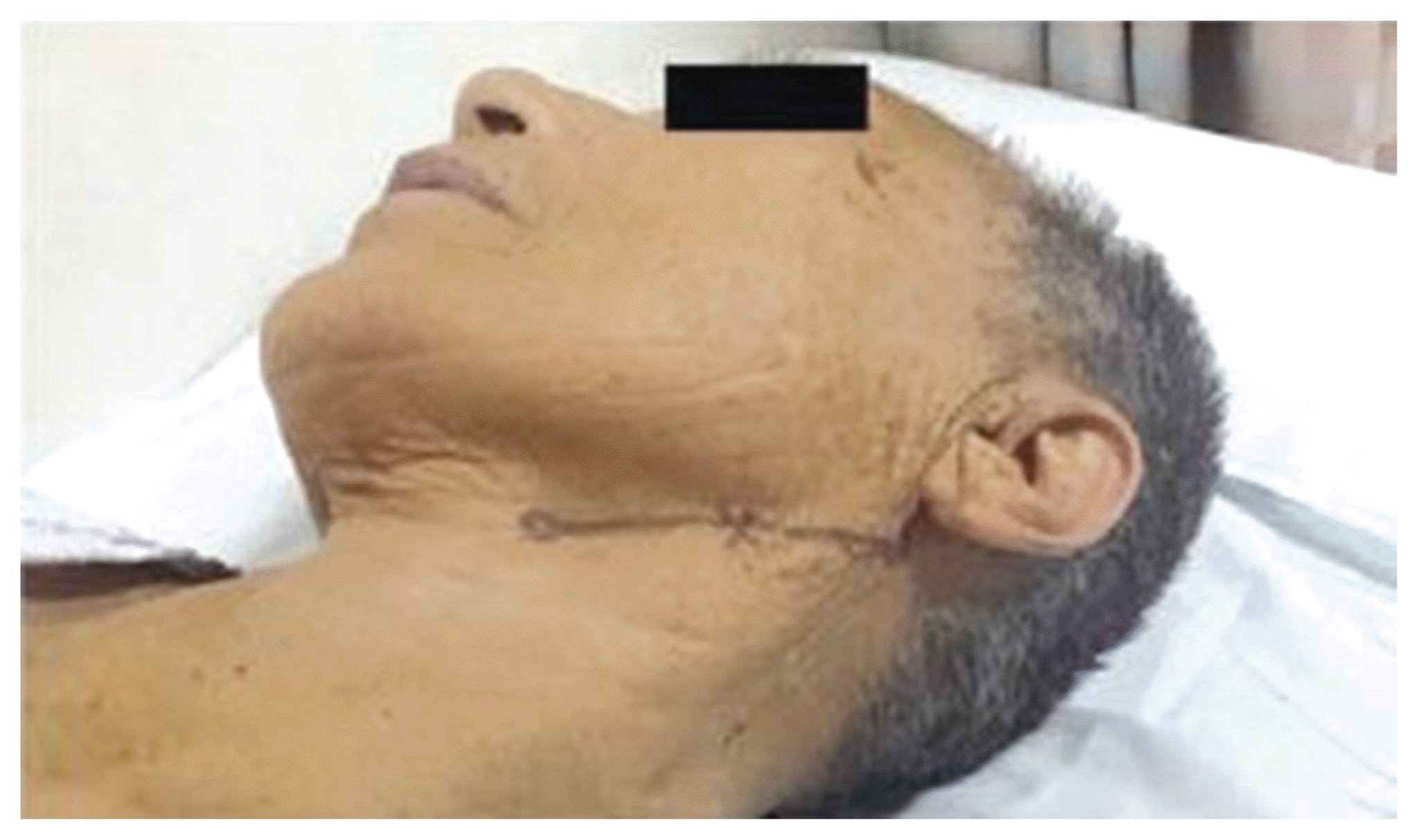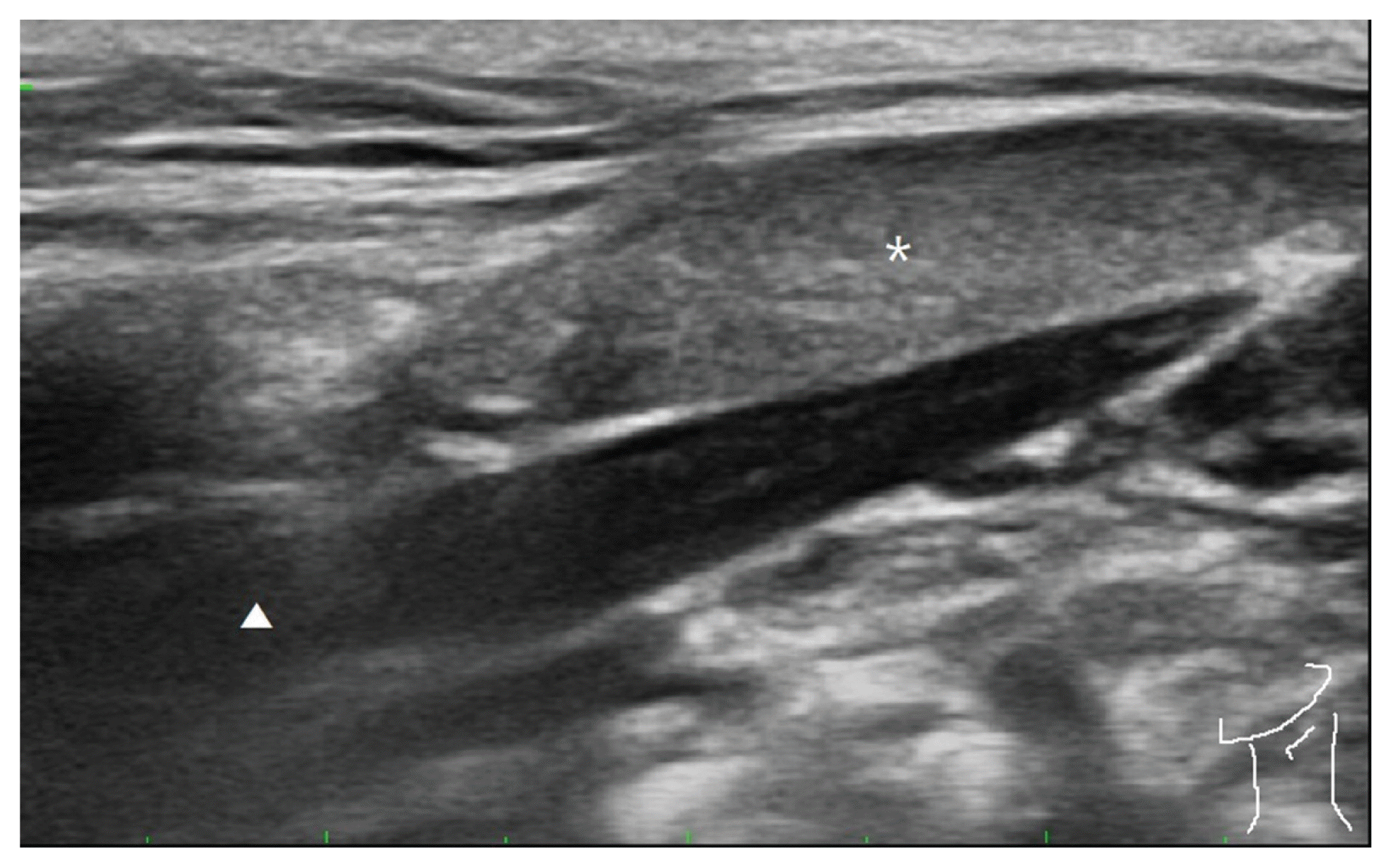Abstract
Foreign body (FB) sensation in the throat is often a common symptom encountered in clinical practice. FB sensation in throat has numerous causes mainly caused by reflex diseases such as laryngopharyngeal reflux. Its treatment has been focused on organic problems or hysteria while musculoskeletal problem has been neglected. We hereby report a patient with dysphagia and complaint of FB sensation in the throat after nasogastric tube removal. It was relieved by trigger point injection on the posterior belly of digastric muscles.
Go to : 
Foreign body (FB) sensation in the throat is a symptom of intermittent or sustained painless feeling of lump in the throat. It can be easily encountered around the neighborhood due to prolonged symptoms, not easy to treat, and frequent recurrence. This sensation in the throat tends to improve when one eats food. It is characterized by tenderness or the absence of tenderness. The exact cause remains unclear however; many recent studies have reported a link of FB sensation with laryngopharyngeal reflux (LPR) or gastroesophageal reflux disease (GERD). In addition to reflux diseases, many studies have reported various causal diseases such as psychological problem.1 The digastricus (digastric muscle) is located in the suprahyoid region which consists of anterior belly, intermediate tendon, and posterior belly. It acts to elevate the hyoid bone that opens the jaw when the masseter and the temporalis are relaxed. The posterior belly, longer than the anterior belly, often has trigger points with symptoms of FB sensation (Fig. 1). This report describes a patient with dysphagia and complaint of FB sensation in the throat after nasogastric tube removal. It was relieved by trigger point injection (TPI) on the posterior belly of digastric muscles.
Written informed consent of the treatment and this report were obtained from the patient. A 75-year-old woman felt sudden development of headache and motor weakness on the left side. She was diagnosed as right temporo-parieto-occipital lobe intracerebral hemorrhage on May 3, 2018. She was first admitted to the Department of Neurosurgery via emergency room. She received operative treatment of free hand aspiration on temporo-occipital hematoma. She was then referred because of swallowing difficulty and gait disturbance on May 27, 2018.
The patient had relative intact cognition that score of 27 of Korean-Mini Mental State Examination (K-MMSE), and intact oromotor skills of jaw, tongue, lip movement, orofacial sense, and oral reflex at two weeks after treatment of dysphagia therapy with VitalStim®, direct feeding training, compensation technique, and direct neck muscle stimulation. Video fluoroscopy swallowing study(VFSS) on June 16, 2018 showed 18/100 points of Functional Dysphagia Scale with intact oral stage and trigger of pharyngeal swallow below 10% of the vallecula and pyriform sinus residues accompanied by water penetration and pharyngeal coating (Fig. 2). Nectar-like dysphagia diet per os was offered after nasogastric (NG) tube removal consequently.
Lump or FB sensation occurred right after the NG tube removal. Proton pump inhibitor (PPI, esomeprazol 20 mg) was administered empirically. However, the symptom described above did not disappear. Computed tomography (CT) of the neck (enhanced) revealed no definite abnormal finding in laryngeal or pharyngeal area. There was no definite sign of LPR on fiberoptic laryngoscopy either.
On September 24, 2018, after 3 months of NG tube removal, she complained of a persistent FB sensation although the administration of PPI for 3 months. Careful and thorough physical examination was done on the surface of the neck. We palpated multiple trigger points on the posterior belly of the digastric muscle by rubbing across fibers behind the angle of the mandible and by sliding finger upward toward the anterior border of the sternocleidomastoid muscle (Fig. 3).2 TPI was done using a dry needle with Hong technique3 on both sides of the posterior belly of the digastric muscle by ultrasound (iU22, Phillips Medical Systems, Bothell, WA, USA) guidance (Fig. 4, 5). Local twitch responses were seen. Right after that, FB sensation was relieved. The patient has not hitherto reported any residual symptoms.
Go to : 
The causes of FB sensation is a relatively common symptom. Although many studies have recently reported about its association with LPR or GERD, it can be caused by a variety of causes such as nonspecific esophageal motility disorder, psychological cause, upper respiratory inflammation and tumors, thyroid disease, cervical heterotopic gastric mucosa, and so on.4–6 Treatment of FB sensation includes anti-reflux therapy such as PPI, prokinetics, surgical treatment such as laparoscopic Nissen fundoplication, thyroidectomy, partial epiglottectomy, speech and language therapy, relaxation therapy, cognitive-behavioral therapy, and antidepressants. In a study on the natural progression of patients with FB sensation, 50 to 60 percent of patients showed improvement in symptoms without special treatment. However, there are no standardized diagnostic or treatment methods for this yet.4–7
A patient with dysphagia or NG tube often has complaints of symptoms of FB sensation, although such link lacks comprehensive studies.8,9 Anterior neck muscles can move the hyoid bone that opens and closes the jaw followed by swallowing sequences. However, there is not much research about functional impairment of the anterior neck muscle. It is unclear whether myofascial trigger points can cause FB sensation. Myofascial trigger points are focal "knots" located in a taut band of skeletal muscle first described by Dr. Janet Travell in 1942.10 These points are usually palpable. They produce a characteristic referred pain upon palpation, along with pain locally. They can also cause stiffness, decrease the range of muscle motion, and inhibit muscle strength.11
For stroke patients, the movement of neck muscle is restricted for a number of reasons. Limited muscle movement is a cause of myofascial trigger points.10 Especially in patients with NG tube removed, the stimulus has been thought to be the cause of FB sensation. However, FB sensation due to myofascial trigger points has been overlooked.12 Consequently, our case is based on the evidence described above that myofascial trigger points might cause FB sensation. Hereby we report that trigger point release by injection might help manage FB sensation.
Posterior belly of the digastric muscle in conjunction with suprahyoid muscles is involved in the stabilization of the position of the hyoid bone. When tension in the posterior belly of the digastric muscle is associated with FB sensation, trigger point release by injection might be helpful for a patient without etiological abnormal findings of VFSS, laryngoscopy, or radiological study like CT or MRI.
Evidently, our case may not conclusively demonstrate mechanisms of relieved FB sensation by trigger point injection. Moreover, our case also had limitations that not be verified with measuring tools like Glasgow-Edinburgh Throat Scale (GETS) or Esophageal symptoms questionnaire (ESQ) for the assesement of globus. However, this case report provides one small step toward treatment of FB sensation after many kinds of brain disorders.
Go to : 
REFERENCES
1. Malcomson KG. Globus hystericus vel pharyngis (a recommaissance of proximal vagal modalities). J Laryngol Otol. 1968; 82:219–30.
2. Burch JG. Occlusion related to craniofacial pain. Philadelpia(PA): Lea & Febiger;1977.
3. Hong CZ. Lidocaine injection versus dry needling to myofascial trigger point. The importance of the local twitch response. Am J Phys Med Rehabil. 1994; 73:256–63.
4. Harvey PR, Theron BT, Trudgill NJ. Managing a patient with globus pharyngeus. Frontline Gastroenterol. 2018; 9:208–12.

5. Lee BE, Kim GH. Globus pharyngeus: a review of its etiology, diagnosis and treatment. World J Gastroenterol. 2012; 18:2462–71.

6. Jarvenpaa P, Arkkila P, Aaltonen LM. Globus pharyngeus: a review of etiology, diagnostics, and treatment. Eur Arch Otorhinolaryngol. 2018; 275:1945–53.

7. Penović S, Roje Ź, Brdar D, Graćan S, Bubić A, Vela J, et al. Globus Pharyngeus: A Symptom of Increased Thyroid or Laryngopharyngeal Reflux? Acta Clin Croat. 2018; 57:110–5.

9. Miles A, Allen JE. Management of oropharyngeal neurogenic dysphagia in adults. Curr Opin Otolaryngol Head Neck Surg. 2015; 23:433–9.

10. Travell JG, Simons DG. Myofascial Pain and Dysfunction: The Trigger PointManual: The Upper Extremities. 1. Baltimore(MD): Williams & Wilkins;1983.
12. Dommerholt J, Hooks T, Chou LW, Finnegan M. A critical overview of the current myofascial pain literature - November 2018. J Bodyw Mov Ther. 2019; 23:65–73.
Go to : 




 PDF
PDF Citation
Citation Print
Print







 XML Download
XML Download